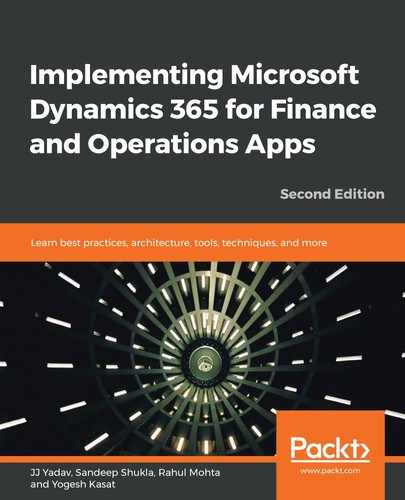Chapter 1, Introduction to Dynamics 365 Finance and Operations, introduces you to Microsoft Dynamics 365 and shares details of various applications. This chapter also describes Finance and Operations basics, core capabilities, deployment options. It describes using AppSource which is one of Microsoft portals to find ISV independent software vendor solutions as well list of partners who could help customers implement Dynamics 365. It also describes how to sign up for a free trial and the ERP implementation team structure.
Chapter 2, Methodology and Initiation, shares information on various implementation methodologies, such as CRP, Agile, and Waterfall for selection, implementation, and maintenance of Finance and Operations.
Chapter 3, Life Cycle Services (LCS) and Tools, introduces Life Cycle Services (LCS) and tools and how they are used to manage your application life cycle from project on-boarding to the implementation and operation of the project.
Chapter 4, Architecture, Deployment, and Environments, explains the Finance and Operations application components and architecture, as well as deployment choices such as cloud and on-premises deployment. It also covers cloud deployment and various aspects of environment planning.
Chapter 5, Requirements and Process Analysis, explains the need for capturing requirements well in SMART (short for Specific, Measurable, Achievable, Realistic, Time-bound) format. This chapter also covers requirements, processes, solution blueprints, and emphasizing the needs of business process and various other aspects of managing the scope of the project.
Chapter 6, Configuration and Data Management, helps you explore configuration management and data migration, data management tools, data management frameworks, data management scenarios, and best practices in managing configurations and data migration.
Chapter 7, Solution Planning and Design, helps you plan and execute functional design and technical design. It also contains tips and tricks with real-life examples of design patterns—both good and bad—to support best practices.
Chapter 8, Integration Technologies, Planning, and Design, covers integration planning and the integration tools and frameworks available in Finance and Operations, as well as best practices for integration design.
Chapter 9, Customization and Extension, helps you explore the things that you need to know before starting development, during development, and after development, such as the development environment, tools, technical concepts, build and versioning strategies, the development process, frameworks, best practices, and automated build and deployment processes.
Chapter 10, Analytics, Business Intelligence, and Reporting, covers the BI and reporting scenarios and tools. The chapter also covers how to use Azure Data Lake and Azure Synapse Analytics to define the analytics data strategy and integrations. It also explains the best practices in analytics, business intelligence, and reporting.
Chapter 11, Testing and Training, helps you understand the new features and techniques of testing. It also takes you through different testing scenarios and shows the readers some of the best practices in testing and training.
Chapter 12, Managing Go-Live and Post Go-Live, helps you to plan for a successful go-live and explains how you can support a production environment.
Chapter 13, One Version Service Updates, explores Finance and Operations One Version through topics such as update availability, update early adoption, service updates, quality update, and feature management.
